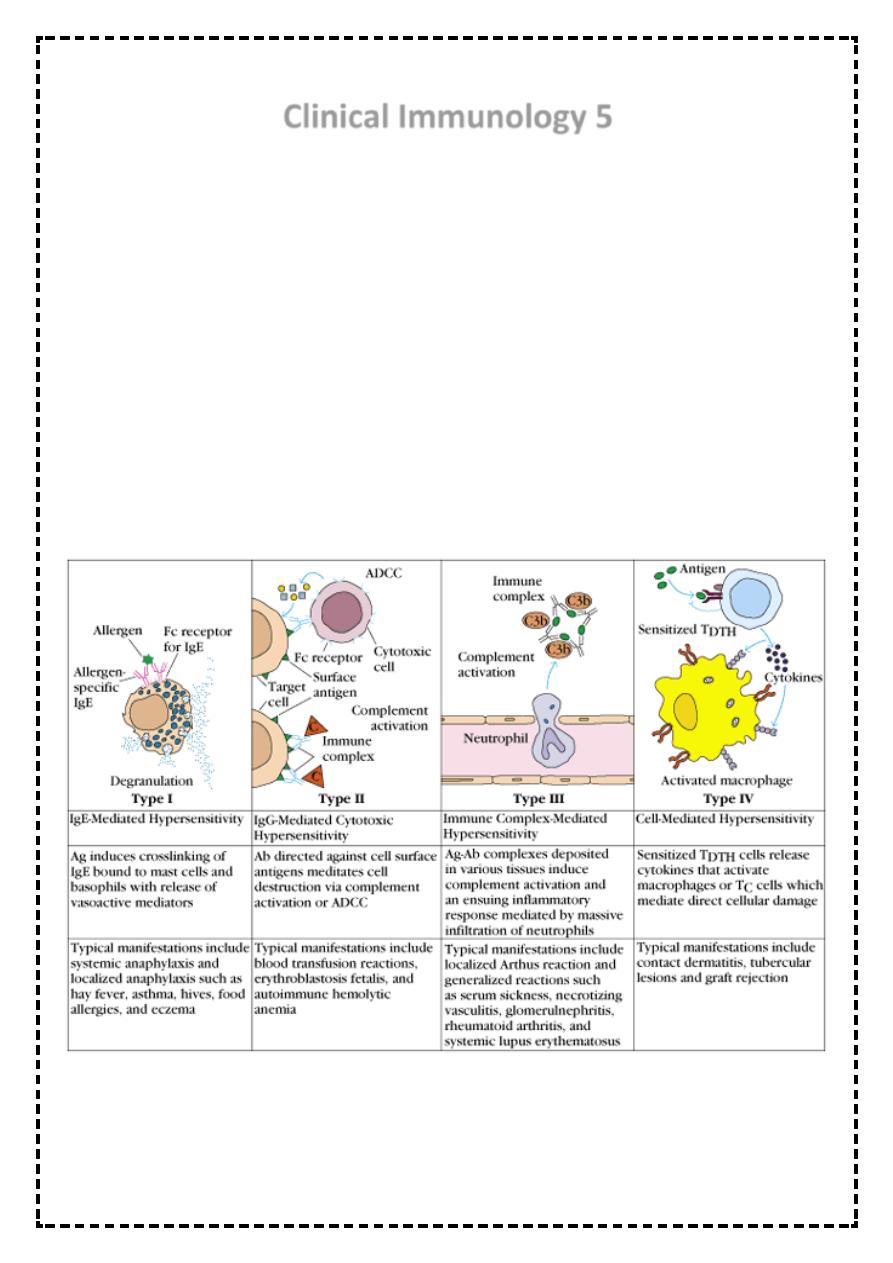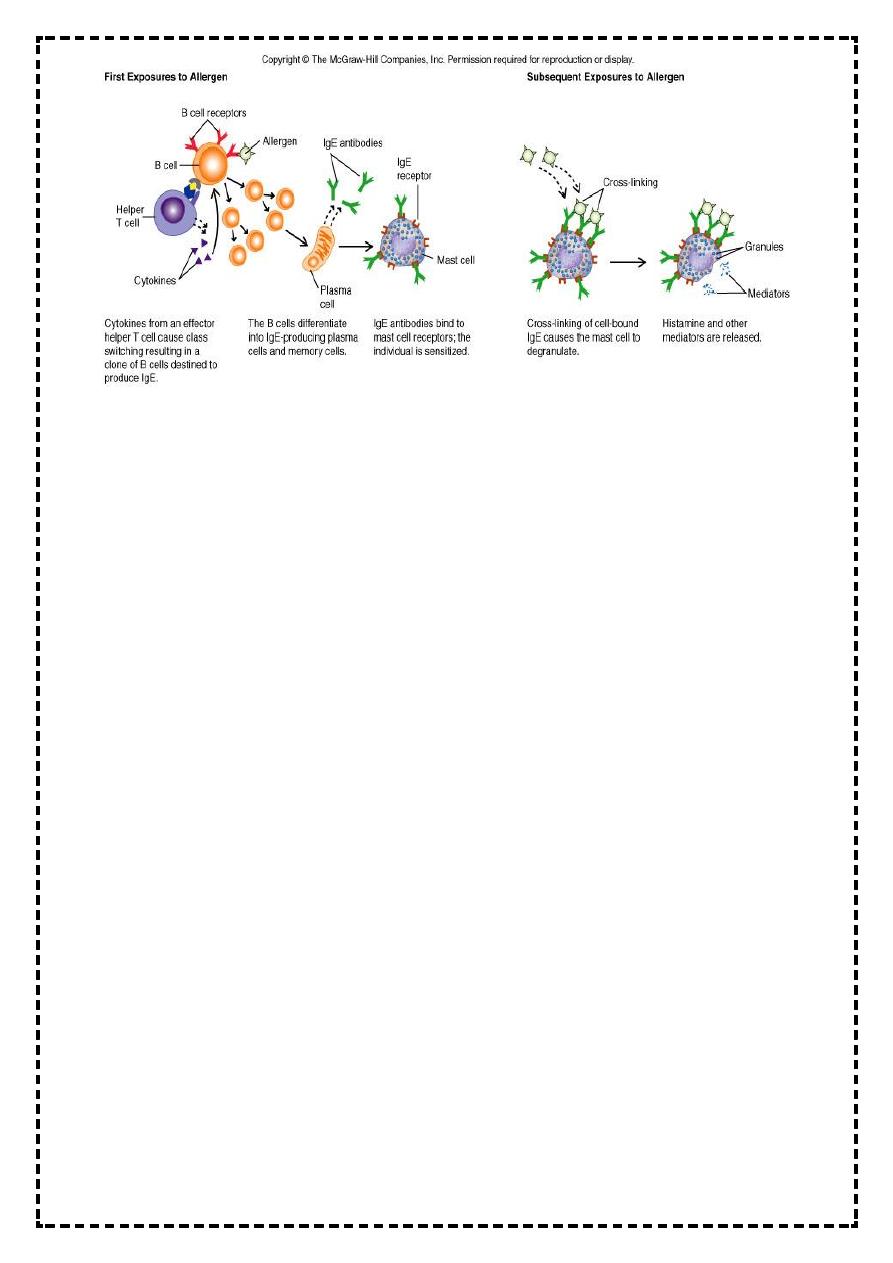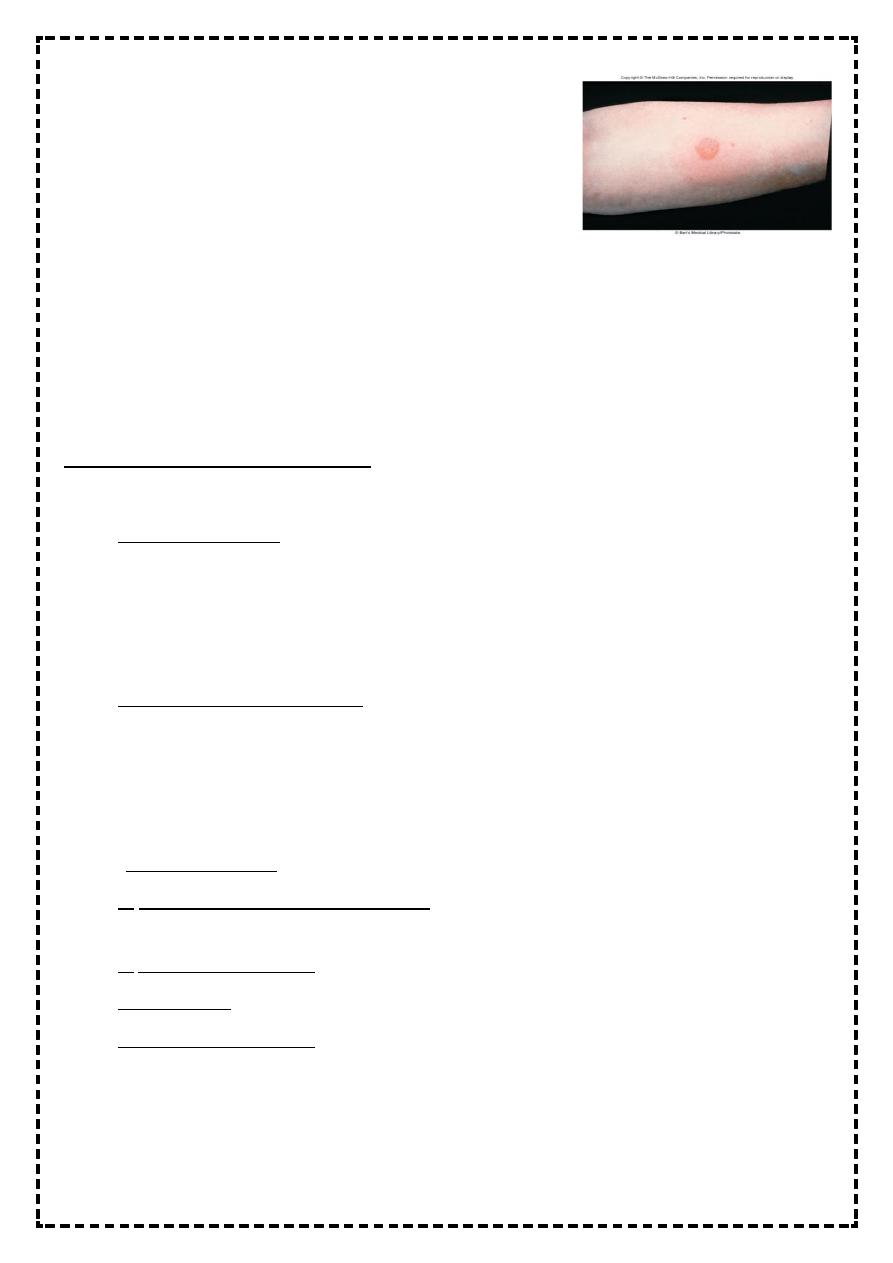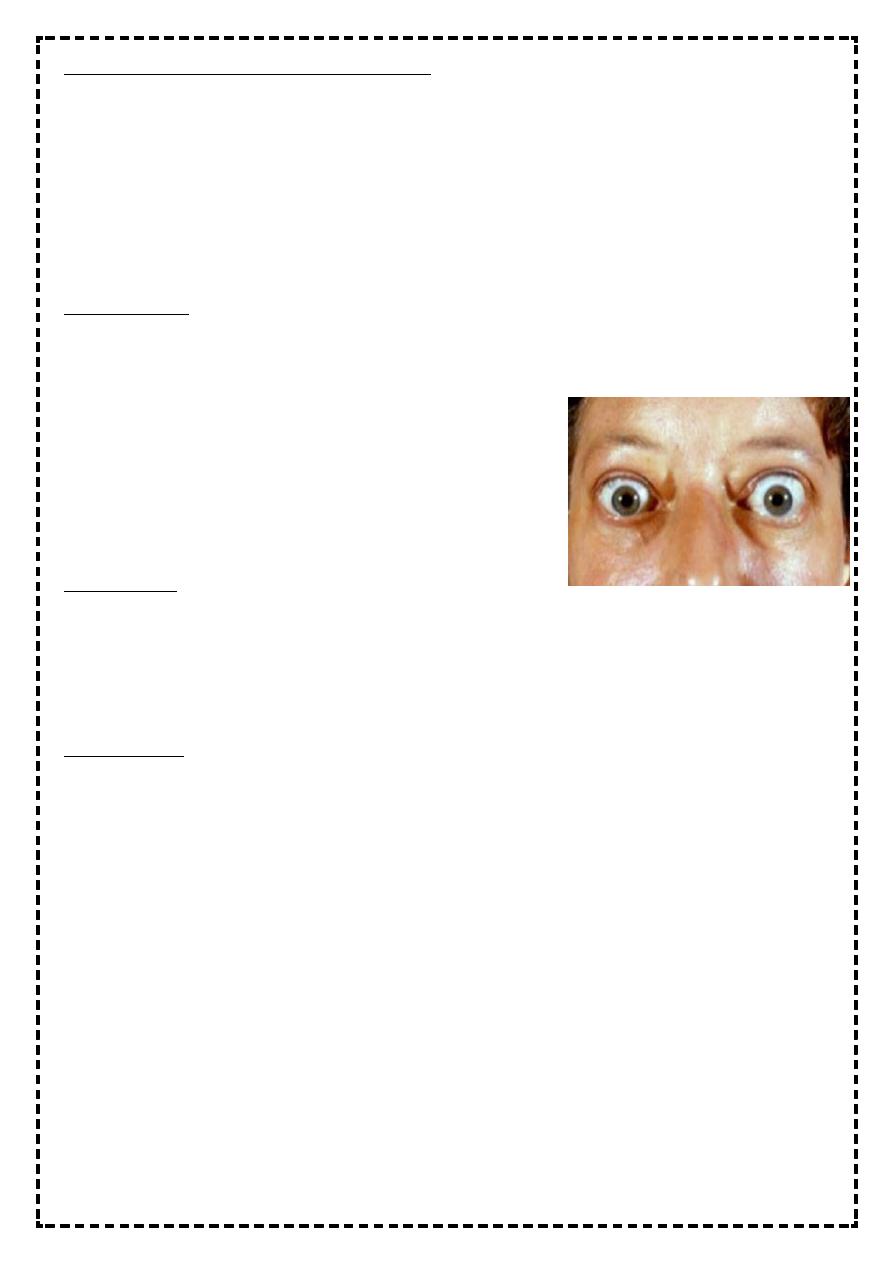
~1
~
Third Stage Internal Medicine Dr. Fadhil
Clinical Immunology 5
Gell & Coomb's classification of hypersensitivity disease
-Hypersensitivity (allergy) is an inappropriate immune response that may develop in the
humoral or cell-mediated responses
-Was first termed anaphylaxis
-can be systematic, which often leads to shock and can be fatal, or localized, which is various
atopic reactions
There are four types of reactions:
Type I-IgE mediated
Type II-Antibody-Mediated
Type III-Immune Complex-Mediated
Type IV-Delayed-Type Hypersensitivity (DTH)
In type I( immediate) hypersensitivity the binding of an antigen to specific IgE bound to its high-
affinity receptors on a mast cell surface results in massive and rapid cell degranulation. The
antigens involved are typically inert molecules present in the environment( termed allergens).

~2
~
• The immediate effects of allergen exposure are often very florid( early phase response),
allergic disorders also have a second phase, occurring a few hours after exposure and last
up to several days. These are called late phase responses(LPR).
• Recruitment of eosinophils is often a prominent feature . From a pathological and
therapeutic viewpoint, the LPR gives rise to chronic inflammation which is difficult to
control. In asthma the LPR can result in prolonged wheezing that can be fatal. Testing of
this type is via skin test for specific IgE.
Type II hypersensitivity or cytotoxic hypersensitivity:
• The antibodies produced by the immune response bind to antigens on the patient’ s own
cell surfaces. These antigens can either be intrinsic ( “self” antigens), in which case the
autoimmune disease is the best example or extrinsic (adsorbed during exposure to some
foreign antigens in case of infection).
• Examples of this type include autoimmune hemolytic anemia, ITP, rheumatic heart
disease, Good pasture’s disease, Grave’s disease& Myasthenia Gravis. Testing is done via
direct& indirect coomb’s test.
• Type -3(immune complex mediated)- IgG binds to soluble antigen on a target cell, which
is actually a host cell that is perceived by the immune system as foreign, leading to
cellular destruction via neutrophil & the subsequent release of lysosomal enzymes.
• E.g.-serum sickness, farmer's lung, arthus reactions(antigen-antibody deposition in
vascular wall, serosa& encountered in experimental local injection of antigen), RA, post
streptococcal glomerulonephritis& SLE .
• Type -4(delayed type, antibody independent)- activated natural killer cells, phagocytes &
T-lymphocytes are included in this reaction.
• How? T-cells find antigen & activate macrophages, eg-type-1 diabetes mellitus, tuberculin
skin test, contact dermatitis, chronic transplant rejection, multiple sclerosis& Hashimato's
disease.

~3
~
ž
Tuberculin skin test
› Test involves introduction of small quantities of
protein antigens from tubercle bacillus into skin
› In positive skin test injection site reddens and
gradually thickens
–
Reaction reaches peak in 2 to 3 days
› Reactions result from sensitized T cells, release of cytokines and influx of
macrophages
• Type –V hypersensitivity reaction is an additional type that is sometimes used as a
distinction from type II. In this condition, the antibodies recognize& bind to the cell
surface receptors. Examples include myasthenia gravis& Grave’s disease.
Investigations of autoimmune disease
Autoantibodies
• a- Rheumatoid factor==antibody directed against the common Fc region of human IgG. It
may be of any Ig class but IgM is commonly tested.
• Only 5% of patients with rheumatoid arthritis are positive for Rheumatoid factor&25%
will become positive in the next two years of the disease.
• Therefore, it poorly sensitive to rule out RA. Also it has low specificity for RA.
• b- antinuclear antibodies(ANA)= are a group of antibodies which bind to the components
of the nucleus.
• The major indication for ANA is in the diagnosis of SLE , with a very high sensitivity
(almost 100%).
• Negative ANA test virtually excludes SLE diagnosis.
• c- anticentromer AB==is positive in CREST variant of scleroderma.
• d- antiribonucleoprotein (anti-RNP) Ab. This is positive in mixed connective tissue
disease.
• e- AntiSmith (anti-Sm)Ab. Very specific for SLE & associated with benign prognosis.
• f- anti DNA Ab. Highly specific for SLE(95%) & associated with more sever disease.
• g- anti- phospholipid Abs. They are associated with development of venous &arterial
thrombosis &recurrent fetal loss as occur in primary antiphospholipid syndrome or as a
complication of SLE.
• Example of such abs---
• Anti-cardiolipin &lupus anticoagulant abs.

~4
~
Antineutrophil cytoplasmic
(
antibodies(ANCA
• Are IgG abs. to cytoplasmic constituents of granulocytes. Two types are found:
• C-ANCA( cytoplasmic) associated with abs. to proteinase-3&occur in 90% of patients with
Wegener's granulomatosis with renal involvement .
• The other type is perinuclear (P-ANCA)& found in patients with Churg-Strauss syndrome.
Examples of autoimmune diseases
Grave's disease
• Characterized by thyrotoxicosis with or without diffuse goiter.
• Clinically such patients had weight loss, goiter with bruit on using stethoscope, heat
intolerance, fatigue, osteoporosis,
• diarrhea, palpitation, HT,
HF, anxiety, tremor, psychosis, hyperreflexia,
amenorrhea, pigmentation, vitiligo, lid lag, lid
retraction, exophthalmos& sweating.
Pathogenesis:
• there is production of IgG abs. directed against thyroid stimulating hormones(TSH)
receptors on thyroid follicular cells which stimulate thyroid hormone production&
hyperthyroidism.
• These abs. are termed TRAb(TSH receptor abs.) which can be detected in 90% of patients.
Management :
• Antithyroid agents carbimasole&
• propylthiouracil for breast feeding or pregnant ladies.
• Subtotal thyroidectomy for large goiter& in whom drug therapy were invalid or
contraindicated.
• Radioactive Iodine is kept for patients over the age of 40 years &recurrence after surgery
but contraindicated in pregnancy.
• Hypothyroidism occurs in 80% of patients after 15 years of treatment with this agent. In
that case, treatment with thyroxin hormone long life is indicated.
